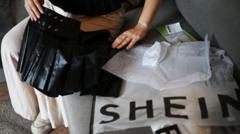The company continues its restructuring efforts while facing tough competition and rising operational costs.
Forever 21 Faces Bankruptcy as It Struggles to Adapt to Market Changes

Forever 21 Faces Bankruptcy as It Struggles to Adapt to Market Changes
Ride through the fashion rollercoaster as Forever 21 announces bankruptcy, but keeps doors open in the US.
Forever 21, the once-iconic fast-fashion retailer, has officially filed for bankruptcy protection in the United States, marking a significant moment in the brand's history. The company's operating entity announced today that while it begins to wind down operations, all US stores and its online platform will remain operational during this process.
Originally a favorite among young shoppers for its trendy, budget-friendly clothing, Forever 21 has faced significant challenges in recent years — from surging retail prices to an influx of online shopping options. The brand previously filed for bankruptcy in 2019 but was rescued through a joint investment venture.
"Despite our efforts, we have struggled to carve out a viable path forward amidst intensifying competition from international fast-fashion brands and rising operational costs affecting our key demographics," stated Brad Sell, the CFO of Forever 21, in an official release. As part of the bankruptcy process, liquidation sales will be initiated across affected stores, and a court-managed sale of assets may be on the horizon.
Under Chapter 11 protection, Forever 21 is granted temporary relief from its creditor obligations, providing a crucial window to restructure its debts or potentially divest parts of its business. It's important to note that the firm’s international operations remain unaffected, as they are managed by separate license holders.
Founded in 1984 in Los Angeles by South Korean immigrants, the brand saw explosive growth and peaked in 2016, operating 800 stores globally — 500 in the U.S. alone. Diversity in shopping behavior and economic pressures appear to have shifted the retail landscape away from brick-and-mortar establishments, creating significant hurdles for the storied fashion retailer.
Originally a favorite among young shoppers for its trendy, budget-friendly clothing, Forever 21 has faced significant challenges in recent years — from surging retail prices to an influx of online shopping options. The brand previously filed for bankruptcy in 2019 but was rescued through a joint investment venture.
"Despite our efforts, we have struggled to carve out a viable path forward amidst intensifying competition from international fast-fashion brands and rising operational costs affecting our key demographics," stated Brad Sell, the CFO of Forever 21, in an official release. As part of the bankruptcy process, liquidation sales will be initiated across affected stores, and a court-managed sale of assets may be on the horizon.
Under Chapter 11 protection, Forever 21 is granted temporary relief from its creditor obligations, providing a crucial window to restructure its debts or potentially divest parts of its business. It's important to note that the firm’s international operations remain unaffected, as they are managed by separate license holders.
Founded in 1984 in Los Angeles by South Korean immigrants, the brand saw explosive growth and peaked in 2016, operating 800 stores globally — 500 in the U.S. alone. Diversity in shopping behavior and economic pressures appear to have shifted the retail landscape away from brick-and-mortar establishments, creating significant hurdles for the storied fashion retailer.





















